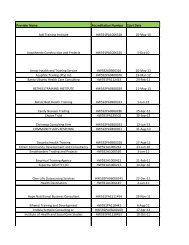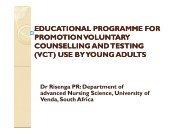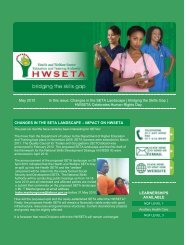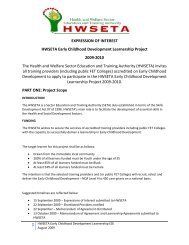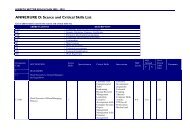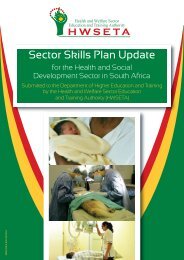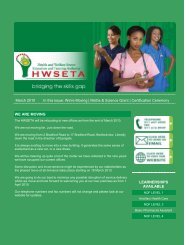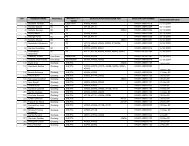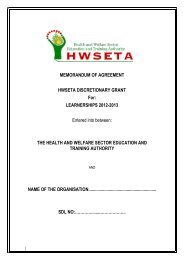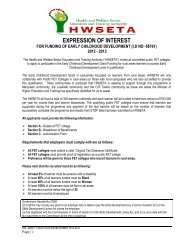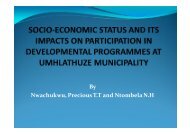sector skills plan for the health sector in south africa
sector skills plan for the health sector in south africa
sector skills plan for the health sector in south africa
Create successful ePaper yourself
Turn your PDF publications into a flip-book with our unique Google optimized e-Paper software.
Cuts <strong>in</strong> prov<strong>in</strong>cial <strong>health</strong> budgets <strong>for</strong> tra<strong>in</strong><strong>in</strong>g, <strong>the</strong> rationalisation of public nurs<strong>in</strong>g colleges (and <strong>the</strong><br />
subsequent closure and merger of many) have had an adverse effect on <strong>the</strong> supply of nurses. 200<br />
b) Community service <strong>for</strong> <strong>health</strong> professionals<br />
The national DoH <strong>in</strong>troduced community service <strong>in</strong> <strong>the</strong> public <strong>sector</strong> <strong>for</strong> 11 <strong>health</strong> professions between<br />
1998 and 2007. Newly qualified <strong>health</strong> professionals serve one year of community service <strong>in</strong> underresourced<br />
areas to enhance access to <strong>health</strong>care and also to develop <strong>the</strong>ir own cl<strong>in</strong>ical <strong>skills</strong><br />
<strong>in</strong>dependently from <strong>the</strong> lecturers at <strong>the</strong>ir <strong>in</strong>stitutions of tra<strong>in</strong><strong>in</strong>g. 201 Each year a number of <strong>the</strong>se <strong>health</strong><br />
professionals are allocated to <strong>the</strong> SA Military Health Services and <strong>the</strong> Department of Correctional<br />
Services.<br />
The <strong>in</strong>troduction of community service has alleviated shortages of <strong>health</strong> personnel <strong>in</strong> <strong>the</strong> public <strong>sector</strong>,<br />
especially <strong>in</strong> <strong>the</strong> rural areas. 202 In 2006 and 2007 <strong>the</strong> number of GPs <strong>in</strong>creased by 20% (but decl<strong>in</strong>ed<br />
aga<strong>in</strong> <strong>in</strong> 2008 when <strong>the</strong> two-year <strong>in</strong>ternship was <strong>in</strong>troduced). The number of occupational <strong>the</strong>rapists<br />
and physio<strong>the</strong>rapists <strong>in</strong> <strong>the</strong> public <strong>sector</strong> <strong>in</strong>creased by at least 33% and 40% respectively, based on<br />
comparisons of <strong>the</strong> number of public <strong>sector</strong> posts available and <strong>the</strong> number of community service<br />
professionals. 203 Although community service helped to alleviate <strong>skills</strong> shortages <strong>in</strong> <strong>the</strong> public <strong>sector</strong>, <strong>the</strong><br />
public <strong>health</strong> services still experience challenges <strong>in</strong> reta<strong>in</strong><strong>in</strong>g professionals – especially <strong>in</strong> <strong>the</strong> rural areas.<br />
c) Salary adjustments<br />
A few years ago <strong>the</strong> DoH <strong>in</strong>troduced rural and scarce skill allowances to attract and reta<strong>in</strong> <strong>health</strong>care<br />
professionals <strong>in</strong> areas of greatest need. 204 The <strong>in</strong>troduction of <strong>the</strong> occupational-specific dispensation <strong>for</strong><br />
nurses <strong>in</strong> <strong>the</strong> public <strong>sector</strong> from March 2008 is also aimed at elim<strong>in</strong>at<strong>in</strong>g salary differentials between <strong>the</strong><br />
private and public <strong>sector</strong>s and reta<strong>in</strong><strong>in</strong>g scarce <strong>skills</strong>. Similar arrangements to reta<strong>in</strong> doctors and midlevel<br />
category doctors <strong>in</strong> <strong>the</strong> public <strong>sector</strong> have been hampered by <strong>in</strong>capacity <strong>in</strong> prov<strong>in</strong>cial <strong>health</strong><br />
departments. 205 The national DoH also agreed to implement occupational-specific remuneration <strong>for</strong><br />
dentists, medical and dental specialists, pharmacist assistants, pharmacist and emergency medical<br />
services personnel, and a proposal was made <strong>for</strong> occupational-specific remuneration <strong>for</strong> <strong>the</strong>rapeutic and<br />
related allied <strong>health</strong> professionals. 206<br />
200 Breier, M., Wildschut, A. and Mgqolozana, T. 2009. Nurs<strong>in</strong>g <strong>in</strong> a New Era – The Professional Education of Nurses <strong>in</strong> South<br />
Africa.<br />
201 National Department of Health. 2006. “Community service to improve access to quality <strong>health</strong> care to all South Africans”.<br />
Published at http://www.doh.gov.za (Accessed August 2010).<br />
202 Lehmann, U. 2008. “Streng<strong>the</strong>n<strong>in</strong>g Human Resources <strong>for</strong> Primary Health Care” South African Health Review.<br />
203 Harrison, D. 2009. An Overview of Health and Health care <strong>in</strong> South Africa 1994-2010: Priorities, Progress and Prospects <strong>for</strong><br />
New Ga<strong>in</strong>s. Published at www.doh.gov.za (Accessed February 2010).<br />
204 Lehmann, U. 2008. “Streng<strong>the</strong>n<strong>in</strong>g Human Resources <strong>for</strong> Primary Health Care”. South African Health Review 2008. Health<br />
Systems Trust. Published at www.hst.org.za/publications/841 (Accessed August 2010).<br />
205 Bateman, C. 2010. “Occupation-specific dispensation – a hapless tale”. South African Medical Journal. May 2010. 100 (5).<br />
Published at http://www.scielo.org.za/pdf/samj/V100n5. (Accessed August 2010).<br />
206 National Treasury. 2010. “Vote 15: Health”. Estimates of National Expenditure 2010.<br />
74



